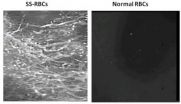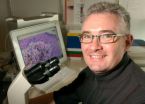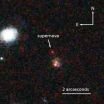(Press-News.org) DURHAM, N.C. – By harnessing the very qualities that make sickle cell disease a lethal blood disorder, a research team led by Duke Medicine and Jenomic, a private cancer research company in Carmel, Calif., has developed a way to deploy the misshapen red blood cells to fight cancer tumors.
Reporting in the Jan. 9, 2013, edition of the on-line journal, PLOS ONE, the researchers describe a process of exploiting sickle-shaped red blood cells to selectively target oxygen deprived cancer tumors in mice and block the blood vessels that surround them.
"Sickle cells appear to be a potent way to attack hypoxic (oxygen-starved) solid tumors, which are notable for their resistance to existing cancer chemotherapy agents and radiation," said senior author Mark W. Dewhirst, DVM, PhD, a radiation oncologist and director of Duke's Tumor Microcirculation Laboratory. "This is an exciting finding that suggests a potential new approach to fighting tumors that are currently associated with aggressive disease."
"The very qualities that make sickle cells a danger to people with the inherited genetic disorder can be turned against tumors to fight cancer," said lead author David S. Terman, M.D., head of Molecular Genetics at Jenomic. "Our approach using sickle cells is a novel strategy with broad therapeutic potential that could be directed at breast cancers, prostate cancers, and many other solid tumors that develop resistance to current therapies."
Sickle cells are typically associated with a potentially life-threatening disease in which red blood cells are deformed in the shape of a crescent moon or sickle. Unlike healthy red blood cells that flow smoothly through vessels, the sickle cells get stuck, causing blockages that are painful and damaging to tissue.
A collaborative effort between Duke researchers and scientists from Jenomic began in 2006 to explore whether sickle cells could similarly build clots in the vast networks of blood vessels that feed oxygen-starved, or hypoxic, cancer tumors, which can grow increasingly lethal as their oxygen needs escalate.
In a National Institutes of Health-funded study of mice with breast cancer, the researchers gave the animals an infusion of fluorescently dyed sickle cells and viewed them under special window chambers that provide real-time observation of processes inside the body. Within five minutes, the deformed cells began to adhere to the blood vessels surrounding the hypoxic tumors. Over 30 minutes, the cells had formed clots and began blocking the small blood vessels that fed the tumor.
Dewhirst said the sickle cells stick like Velcro to the hypoxic tumor because it produces an abundance of adhesion molecules as part of its distress from oxygen deprivation. Normal cells don't produce the adhesion molecules, so there's nothing for the sickle cells to snag onto.
"Unlike normal red blood cells, we found that sickle cells show a highly unique natural attraction to oxygen deprived tumors where they stick, cluster and plug tumor blood vessels. Once clustered within the tumor, the sickle cells deposit a toxic iron residue as they die, causing tumor cell death," Terman said.
To boost that caustic effect, the researchers added zinc compounds (zinc protoporphyrin alone or in combination with doxorubicin) to the sickle cells, which caused even greater oxidative stress in the tumor and surrounding blood vessels. This resulted in a dramatic delay in tumor growth, quadrupling the amount of time the tumors were inactive compared to tumors exposed to regular blood cells. Mice showed no acute toxicity to the sickle cell treatment.
"In contrast to drug treatments directed only to the hypoxic tumor cell, our approach uses the inherent qualities of sickle cells to induce injury to the tumor and the vascular micro-environment that feeds the tumor," Terman said.
Dewhirst and Terman said the research team would continue to conduct studies in animals before moving to human trials.
INFORMATION:
In addition to Dewhirst and Terman, study authors included Benjamin L. Viglianti of the University of Michigan; Rahima Zennadi, Diane Fels, Gerald Grant, Zahid N Rabbani, Ejung Moon, Lan Lan, Yiting Cao, Kathleen Ashcraft, Marilyn J. Telen and Greg Palmer of Duke Medicine; Richard J. Boruta and Hong Yuan of the University of North Carolina at Chapel Hill; Mathew R. Dreher of the National Institutes of Health; Joseph Eble, Mayo Clinic; Brian Sorg of the National Cancer Institute.
The National Institutes of Health funded the study (Grants #CA40355-23, -24, -25, -26, 27). Terman holds patents on the findings.
Sickle cells show potential to attack aggressive cancer tumors
2013-01-10
ELSE PRESS RELEASES FROM THIS DATE:
Johns Hopkins scientists use Pap test fluid to detect ovarian, endometrial cancers
2013-01-10
Using cervical fluid obtained during routine Pap tests, scientists at the Johns Hopkins Kimmel Cancer Center have developed a test to detect ovarian and endometrial cancers. In a pilot study, the "PapGene" test, which relies on genomic sequencing of cancer-specific mutations, accurately detected all 24 (100 percent) endometrial cancers and nine of 22 (41 percent) ovarian cancers. Results of the experiments are published in the January 9 issue of the journal, Science Translational Medicine.
The investigators note that larger scale studies are needed before clinical implementation ...
Mapping the Milky Way: Radio telescopes give clues to structure, history
2013-01-10
Astronomers have discovered hundreds of previously-unknown sites of massive star formation in the Milky Way, including the most distant such objects yet found in our home Galaxy. Ongoing studies of these objects promise to give crucial clues about the structure and history of the Milky Way.
The scientists found regions where massive young stars or clusters of such stars are forming. These regions, which astronomers call HII (H-two) regions, serve as markers of the Galaxy's structure, including its spiral arms and central bar.
"We're vastly improving the census of our ...
Mount Sinai researchers foresee new therapies and diagnostics for deadly fibrotic diseases
2013-01-10
A team of scientists has developed a playbook for ending the devastating impact of fibrotic diseases of the liver, lung, kidney, and other organs, which are responsible for as many as 45 percent of all deaths in the industrialized world. Despite the prevalence of these illnesses, which are caused by buildup of scar tissue, there are no approved antifibrotic drugs on the market in the U.S. A top fibrosis expert from the Icahn School of Medicine at Mount Sinai and three other institutions have described drug targets and compounds they hope will prove broadly effective in ...
Drug-resistant melanoma tumors shrink when therapy is interrupted
2013-01-10
Researchers in California and Switzerland have discovered that melanomas that develop resistance to the anti-cancer drug vemurafenib (marketed as Zelboraf), also develop addiction to the drug, an observation that may have important implications for the lives of patients with late-stage disease.
The team, based at the University of California, San Francisco (UCSF), the Novartis Institutes for Biomedical Research (NIBR) in Emeryville, Calif., and University Hospital Zurich, found that one mechanism by which melanoma cells become resistant to vemurafenib also renders them ...
The farthest supernova yet for measuring cosmic history
2013-01-10
What if you had a "Wayback Television Set" and could watch an entire month of ancient prehistory unfold before your eyes in real time? David Rubin of the U.S. Department of Energy's Lawrence Berkeley National Laboratory (Berkeley Lab) presented just such a scenario to the American Astronomical Society (AAS) meeting in Long Beach, CA, when he announced the discovery of a striking astronomical object: a Type Ia supernova with a redshift of 1.71 that dates back 10 billion years in time. Labeled SN SCP-0401, the supernova is exceptional for its detailed spectrum and precision ...
Spin and bias in published studies of breast cancer trials
2013-01-10
Spin and bias exist in a high proportion of published studies of the outcomes and adverse side-effects of phase III clinical trials of breast cancer treatments, according to new research published in the cancer journal Annals of Oncology [1] today (Thursday).
In the first study to investigate how accurately outcomes and side-effects are reported in breast cancer trials, researchers at the Princess Margaret Cancer Centre and University of Toronto (Toronto, Canada) found that in a third of all trials that failed to show a statistically significant benefit for the treatment ...
Particles of crystalline quartz wear away teeth
2013-01-10
This press release is available in German.
Dental microwear, the pattern of tiny marks on worn tooth surfaces, is an important basis for understanding the diets of fossil mammals, including those of our own lineage. Now nanoscale research by an international multidisciplinary group that included members of the Max Planck Institute for Evolutionary Anthropology in Leipzig has unraveled some of its causes. It turns out that quartz dust is the major culprit in wearing away tooth enamel. Silica phytoliths, particles produced by plants, just rub enamel, and thus have ...
First image of insulin 'docking' could lead to better diabetes treatments
2013-01-10
A landmark discovery about how insulin docks on cells could help in the development of improved types of insulin for treating both type 1 and type 2 diabetes.
For the first time, researchers have captured the intricate way in which insulin uses the insulin receptor to bind to the surface of cells. This binding is necessary for the cells to take up sugar from the blood as energy.
The research team was led by the Walter and Eliza Hall Institute and used the Australian Synchrotron in Melbourne, Australia. The study was published today in the journal Nature.
For more ...
Magma in mantle has deep impact
2013-01-10
HOUSTON – (Jan. 9, 2013) – Magma forms far deeper than geologists previously thought, according to new research at Rice University.
A group led by geologist Rajdeep Dasgupta put very small samples of peridotite under very large pressures in a Rice laboratory to determine that rock can and does liquify, at least in small amounts, as deep as 250 kilometers in the mantle beneath the ocean floor. He said this explains several puzzles that have bothered scientists.
Dasgupta is lead author of the paper to be published this week in Nature.
The mantle is the planet's middle ...
After decades of research, scientists unlock how insulin interacts with cells
2013-01-10
The discovery of insulin nearly a century ago changed diabetes from a death sentence to a chronic disease.
Today a team that includes researchers from Case Western Reserve University School of Medicine announced a discovery that could lead to dramatic improvements in the lives of people managing diabetes.
After decades of speculation about exactly how insulin interacts with cells, the international group of scientists finally found a definitive answer: in an article published today in the journal Nature, the group describes how insulin binds to the cell to allow the ...




